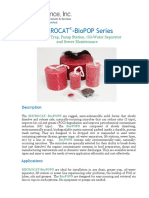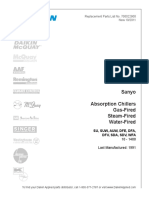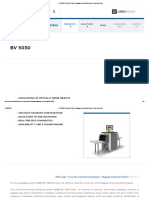What Is A Grease Trap?
What Is A Grease Trap?
Uploaded by
Awais JalaliCopyright:
Available Formats
What Is A Grease Trap?
What Is A Grease Trap?
Uploaded by
Awais JalaliOriginal Description:
Original Title
Copyright
Available Formats
Share this document
Did you find this document useful?
Is this content inappropriate?
Copyright:
Available Formats
What Is A Grease Trap?
What Is A Grease Trap?
Uploaded by
Awais JalaliCopyright:
Available Formats
2011 Advanced Waste Services, Inc. All Rights Reserved.
The Industrial Waste ProfessionalsTM
Grease Goblin
Grease Trap 101
What Is A Grease Trap?
A grease trap is an engineered device designed to remove spent Fats, Oils and Grease (FOG) and associated solids and debris from food service establishment waste streams, preventing entry of these materials into either municipal sewer collection systems or privately owned on-site wastewater treatment facilities. The grease trap captures those wastes and contains them until a waste hauler or pumper service can properly dispose them. If you operate a food service establishment, you should have and maintain a grease trap. This fact sheet is intended to provide food service establishments with basic common misconceptions about their use; how are they cleaned and maintained; and who regulates their use. One of the primary purposes of a properly sized grease trap is to retain high temperature spent FOG until cooling and separation of the spent FOG and water can take place. The retention of food service solids lost to the waste stream is also an important function of a grease trap. Large particle solids, with masses greater than that of water, settle to the bottom of the grease trap and are intended for removal along with the floatable spent FOG during periodic cleaning.
Basic In-Ground Grease Trap Design
1|Page Transforming Todays Wastes Into Tomorrows Resources
Types of Grease Traps 1) In-Kitchen Passive Interceptors These units collect grease as it rises to the top of a small baffled tank when wastewater generated in the facility flows through the unit. The collected grease from these types of traps must be removed manually. Because of their relative small size (typically 20-25 gallons), these traps must be cleaned on a short periodic interval (usually ranging from daily to once a week), depending on the load at each particular food service establishment. If these small units are not cleaned accordingly, they quickly become full of grease and allow spent FOG to enter directly into the waste stream. However, if maintained properly, In-Kitchen Passive Interceptors can remove spent FOG and associated solids at a rate of 95%. 2) In-Ground Grease Traps A pre-case concrete grease trap operates on the same principle as the in-kitchen type, only on a larger scale. The most common sizes of in-ground grease traps are in the range of 750 to 2,000 gallons. These larger traps are capable of handling much larger volumes of spent FOG and related material than in-kitchen types. Food service establishments using these larger grease traps must have grease-plumbing companies like AWS clean the traps periodically. Installing a grease trap of this type while a new food service establishment is under construction will have an average cost of $2,500 to $4,000. For any grease trap to be effective, the units must be properly sized, constructed, installed and maintained in a location to provide an adequate retention time for settling and accumulation of the FOG. Also, food service operations must ensure that all grease-bearing drains at their facility discharge to the grease trap. Drain locations may include mop sinks, woks, wash sinks, prep sinks, utility sinks, pulpers, dishwashers, pre-rinse sinks, can washes and floor drains in food preparation areas such as those near a fryer or tilt/steam kettle. No toilet wastes should be plumbed to the grease trap.
Common Grease Trap Misconceptions
Misconception #1: Grease traps are wastewater treatment devices. Food service establishments unknowingly think of grease traps in the same light as wastewater septic tanks, viewing them as treatment systems that only have to be maintained and serviced when a problem occurs. Ive been here for eleven years now, said one restaurant owner. Ive never even looked in the thing (grease trap), never had a problem with it, its always worked great. This misconception not only leads to the discharge of brown grease into waste streams, but in some cases, food service operations with no outlet for yellow grease simply pour it down kitchen drains with hot water, thinking the grease trap will treat the spent FOG. Grease traps are simple primary separation devices that are designed to retain spent FOG and solids long enough for them to be manually or automatically removed. Grease traps are not systems that treat wastewater.
2|Page Transforming Todays Wastes Into Tomorrows Resources
Misconception #2: Kitchen floor drains are the largest source of brown grease in a food service establishment. Contrary to popular perception, food service kitchen floor drains receive relatively little waste, which is usually limited to periodic cleaning and wash down and has minimal impact on grease intercepting equipment. Most spent FOB released to the waste stream in food service kitchens is generated from equipment associated with dishwashing. Multicompartment pot washing sinks, pre-rinse stations and automatic commercial dishwashers generate more spent FOG destined for brown grease than any other source. On-site testing in food service kitchens has shown that nearly 90% of spent FOG is lost in these dishwashing areas.
Cleaning & Maintaining Grease Traps
A grease trap should be checked and maintained to ensure it is working properly. Backups, odors and drainage problems are signs that the grease trap is not functioning as it should. By far, the greatest factors affecting the amount of spent FOG released to the waste stream in any food service establishment are the cleaning and maintenance techniques of the kitchen staff. The care taken by staff to dry scrape leftover food and spent FOG from cooking utensils, food preparation equipment and dishes prior to using water is key to reducing the loading of grease traps. Also, the disposing of wastes such as leftover milk and other beverages can have a major effect on the waste stream. Best Practices regarding cleaning and maintaining grease traps include: Dry Cleanup dont use the hose as a broom! Prevent spills this reduces waste and the need for cleanup. Train all staff on the location, purpose and function and proper maintenance of grease trap and interceptors on a frequent basis. Assure that maintenance is conducted on a regular schedule and is written into policies and procedures for facility. The most important management procedure for grease traps is that a company representative be present during any cleaning, pumping or skimming performed by a contractor. This safeguard permits management to respond appropriately to any questions about the services performed. Pump out schedules should be properly established and strictly followed. It is important that these pump outs are complete; i.e., the grease caps removed, the sides scraped or hosed down and the trap refilled with water. The contractor should indicate whether the trap is refilled with clean water or water from the trap. Never hot flush (continuously run hot water) the grease trap as the heated, liquefied grease will be flushed down the sewer. While hot flushing may divert the need for pumping, the facility is liable for any costs associated with clogs caused by the flushing.\
3|Page Transforming Todays Wastes Into Tomorrows Resources
Many people assume that the amount of spent FOG generated at a particular site is directly related to the type of food being prepared, but this is often not the case. The importance of maintaining a clean and properly operating grease trap is often unknown or overlooked by food service operators. Because spent FOG fills a grease trap from the top down, it is hard to measure the depth of fullness of a grease trap on a visual inspection. The most important aspect to remember is that as more spent FOG is retained in a grease trap, the more the separation efficiency diminishes.
4|Page Transforming Todays Wastes Into Tomorrows Resources
You might also like
- Sanyo Old Absorption Chiller CatalogueDocument50 pagesSanyo Old Absorption Chiller CatalogueAwais Jalali60% (5)
- CR Service Manual: Computed Radiography SystemDocument75 pagesCR Service Manual: Computed Radiography Systemandrea lizeth martinez camachoNo ratings yet
- STPDocument16 pagesSTPlaughingwaters100% (1)
- Ovivo Clarifier 30 P BR 1Document4 pagesOvivo Clarifier 30 P BR 1AdyBorsosNo ratings yet
- Calpeda MXV-B Vertical Multistage PumpDocument6 pagesCalpeda MXV-B Vertical Multistage PumpWayne Seaman100% (1)
- Shortcut Nitrogen Removal-Nitrite Shunt and DeammonificationFrom EverandShortcut Nitrogen Removal-Nitrite Shunt and DeammonificationNo ratings yet
- Bill of Quantities For Plant Room FloorDocument3 pagesBill of Quantities For Plant Room FloorAwais JalaliNo ratings yet
- Stepper Motor With A4988 and Arduino Tutorial (4 Examples)Document40 pagesStepper Motor With A4988 and Arduino Tutorial (4 Examples)tor unlarNo ratings yet
- Design For Oil& Greese TrapDocument11 pagesDesign For Oil& Greese Trapmirza_adil99100% (1)
- Grease Intersiptor Capacity PDFDocument1 pageGrease Intersiptor Capacity PDFbilal almelegyNo ratings yet
- Package Type STPDocument4 pagesPackage Type STPjeykumar.BalannairNo ratings yet
- Grease Trap Installation Operation Maintenance PDFDocument5 pagesGrease Trap Installation Operation Maintenance PDFfrankcysNo ratings yet
- Tank Bottom Scraper Zickert - enDocument22 pagesTank Bottom Scraper Zickert - enzxc007No ratings yet
- Expansion Vessel Size Calculation Sheet Date: December 2015Document1 pageExpansion Vessel Size Calculation Sheet Date: December 2015BelalNor100% (1)
- Grease Trap SizingDocument7 pagesGrease Trap SizingRaheem_kaNo ratings yet
- Fats Oil and Grease (FOG) Treatment in Grease Converters Using BioadditivesDocument12 pagesFats Oil and Grease (FOG) Treatment in Grease Converters Using BioadditivesAria MandalikaNo ratings yet
- Minimum and Peak Flows of WastewaterDocument26 pagesMinimum and Peak Flows of WastewaterSteven Joseph IncioNo ratings yet
- Equalization Process in IndustriesDocument20 pagesEqualization Process in Industriesusmansherdin50% (2)
- Water Pipes and FittingsDocument26 pagesWater Pipes and Fittingsgshazaidi100% (2)
- Aeration System and Oxygen RequirementDocument7 pagesAeration System and Oxygen Requirementdzari6738No ratings yet
- Case Study Fujifilm MBR v01Document2 pagesCase Study Fujifilm MBR v01كرم عمروNo ratings yet
- Sewage Treatment Plant PDF in Hindi 1Document64 pagesSewage Treatment Plant PDF in Hindi 1Pankaj Gogoi100% (1)
- HydroClear BrochureDocument12 pagesHydroClear BrochuremutazsalihNo ratings yet
- Reed Bed System FINALDocument12 pagesReed Bed System FINALHardik Kashyap VepariNo ratings yet
- 25 KLD - STPDocument12 pages25 KLD - STPranjeet.globalgreenNo ratings yet
- Novel Technologies Used in Wastewater Treatment in Fertilizer IndustryDocument5 pagesNovel Technologies Used in Wastewater Treatment in Fertilizer IndustryManiel TipgosNo ratings yet
- Design of Grit ChambersDocument30 pagesDesign of Grit ChambersGithauri DavidNo ratings yet
- Waste Water TreatmentDocument4 pagesWaste Water TreatmentIbrar ZahidNo ratings yet
- Inclined Plate ClarifierDocument2 pagesInclined Plate ClarifierKelvin SiewNo ratings yet
- Domestic Waste Water Treatment PPDocument9 pagesDomestic Waste Water Treatment PPPreetam Godbole100% (1)
- WWTP Chap 5 (p28-41) - Mech PurificationDocument14 pagesWWTP Chap 5 (p28-41) - Mech PurificationKaustav PatnaikNo ratings yet
- Interceptors: S-WD-INTER-1 0812Document11 pagesInterceptors: S-WD-INTER-1 0812Athirah Amer HamzahNo ratings yet
- Textile WastewaterDocument43 pagesTextile Wastewatersujal jhaNo ratings yet
- Primary Settling Tank For ETP PDFDocument1 pagePrimary Settling Tank For ETP PDFZahid_DhakaNo ratings yet
- 67952Document89 pages67952lee diquiatco0% (1)
- Waste Water Recycling System-Effluent SystemDocument15 pagesWaste Water Recycling System-Effluent SystemVishal NakraniNo ratings yet
- Waste Water ReportDocument27 pagesWaste Water ReportkomalNo ratings yet
- Dow Membrane CleaningDocument2 pagesDow Membrane CleaningDonatas Bertasius100% (1)
- Frosco Grease InterceptorDocument39 pagesFrosco Grease InterceptorSopi Labu100% (2)
- Chillers - CatalogDocument2 pagesChillers - Catalogdéborah_rosalesNo ratings yet
- 5 Final CoagulationDocument19 pages5 Final CoagulationGroup-4 CommonNo ratings yet
- Lab 9 Chlorine Residual and Chlorine DemandDocument7 pagesLab 9 Chlorine Residual and Chlorine DemandWaleed EmaraNo ratings yet
- Wastewater Treatment Methods Physical Unit Operations Chemical Unit Operations Biological Unit OperationsDocument34 pagesWastewater Treatment Methods Physical Unit Operations Chemical Unit Operations Biological Unit OperationsNuman100% (1)
- Sewage Treatment Plant: MD - ShamsuzzamanDocument11 pagesSewage Treatment Plant: MD - Shamsuzzamanapi-3701567100% (3)
- Tube SettlersDocument3 pagesTube Settlersmsajidfcc100% (1)
- Energy Saving in Spray Drying ProcessDocument15 pagesEnergy Saving in Spray Drying ProcessJorge OsorioNo ratings yet
- Equipment Catalogue API Oil SeparatorDocument2 pagesEquipment Catalogue API Oil Separatorbesant vargheesNo ratings yet
- Biological Wastewater Treatment BiofiltersDocument66 pagesBiological Wastewater Treatment BiofiltersSalocinNo ratings yet
- Effluent ClarifierDocument2 pagesEffluent ClarifierSutra IrawanNo ratings yet
- Bestec Oil InterceptorsDocument6 pagesBestec Oil InterceptorsSai PrasathNo ratings yet
- Ozone Based Waste Water TreatmentDocument10 pagesOzone Based Waste Water TreatmentZafar BukhariNo ratings yet
- TextileDocument36 pagesTextileDr-Sheetanshu Pandey0% (1)
- Ce 2354Document10 pagesCe 2354Suresh Raju0% (1)
- Biogas From Textile Cotton Waste PDFDocument5 pagesBiogas From Textile Cotton Waste PDFSakthi GaneshNo ratings yet
- Model For Horizontal Tube Settlers PDFDocument203 pagesModel For Horizontal Tube Settlers PDFIlu SinghNo ratings yet
- Thesis Proposal Grease Trap 06.09.2020 RevisedDocument10 pagesThesis Proposal Grease Trap 06.09.2020 Reviseddj4No ratings yet
- Anaerobic Baffled Reactor (ABR) - SSWM PDFDocument9 pagesAnaerobic Baffled Reactor (ABR) - SSWM PDFAnonymous gqtnY7iRk1No ratings yet
- Design and Operation Considerations For Condensate Polishing - T5S5O3-paper PDFDocument17 pagesDesign and Operation Considerations For Condensate Polishing - T5S5O3-paper PDFNhhVuNo ratings yet
- Mini Project ReportDocument5 pagesMini Project ReportSaj BhaiNo ratings yet
- AerationDocument2 pagesAerationglo lipaodNo ratings yet
- Sewage TreatmentDocument34 pagesSewage TreatmentSwayam MehtaNo ratings yet
- Main Features: Meteor Specific TechnologyDocument5 pagesMain Features: Meteor Specific Technologyduyphuong2889No ratings yet
- TrapDocument4 pagesTrapdcsamaraweeraNo ratings yet
- Disposal of Fats, Oils, Grease and Food Waste: Best Management Practice For Catering OutletsDocument10 pagesDisposal of Fats, Oils, Grease and Food Waste: Best Management Practice For Catering OutletsWai SinNo ratings yet
- Research Logistics Transportation Trends 092922Document7 pagesResearch Logistics Transportation Trends 092922Awais JalaliNo ratings yet
- Sample HVAC Survey3Document5 pagesSample HVAC Survey3Awais JalaliNo ratings yet
- BioPOP Data SheetDocument2 pagesBioPOP Data SheetAwais JalaliNo ratings yet
- Ups ChecklistDocument1 pageUps ChecklistAwais Jalali0% (2)
- Standard Car ParkDocument12 pagesStandard Car ParkAwais JalaliNo ratings yet
- Chillers and Boilers Parts ListDocument29 pagesChillers and Boilers Parts ListAwais JalaliNo ratings yet
- Tech PDFDocument3 pagesTech PDFAwais JalaliNo ratings yet
- Fire Damper and Fire Smoke DamperDocument26 pagesFire Damper and Fire Smoke DamperAwais JalaliNo ratings yet
- Treatment of Slaughterhouse Wastewater - CE 479 - Lawrence - Fall 2006Document27 pagesTreatment of Slaughterhouse Wastewater - CE 479 - Lawrence - Fall 2006Gokul SubramaniNo ratings yet
- Basic Principles For Sizing Grease InterceptorsDocument5 pagesBasic Principles For Sizing Grease InterceptorsAwais JalaliNo ratings yet
- SamplemhrabibliographyDocument5 pagesSamplemhrabibliographyAwais JalaliNo ratings yet
- New Seismic Parameters For Building Code of Pakistan and Their Effect On Existing Reinforced Concrete Buildings: A Case StudyDocument7 pagesNew Seismic Parameters For Building Code of Pakistan and Their Effect On Existing Reinforced Concrete Buildings: A Case StudyAwais JalaliNo ratings yet
- Project Plan: SR# Project Start Date Finishing DateDocument2 pagesProject Plan: SR# Project Start Date Finishing DateAwais JalaliNo ratings yet
- Liebert Intellislot Web CardsDocument56 pagesLiebert Intellislot Web CardsMarco TorresNo ratings yet
- Session #103750 - Integrate PeopleSoft and SharePoint - C12 TemplateDocument27 pagesSession #103750 - Integrate PeopleSoft and SharePoint - C12 TemplatejlabrashNo ratings yet
- Inspection & Testing Requirements Scope:: Test and Inspection PerDocument2 pagesInspection & Testing Requirements Scope:: Test and Inspection PerbalajiNo ratings yet
- Over Pressure Cases For Pressure Relief Valve SizingDocument2 pagesOver Pressure Cases For Pressure Relief Valve SizinginstrengNo ratings yet
- VoLTE KPI Report - 9mobileDocument29 pagesVoLTE KPI Report - 9mobileDee OyeNo ratings yet
- CallRecord LogDocument37 pagesCallRecord LogAntonio Castellanos100% (1)
- Medição de COR BLACK BYK Blackness Webinar - 2023 - EDocument21 pagesMedição de COR BLACK BYK Blackness Webinar - 2023 - EClayton EliasNo ratings yet
- Environmental Management SystemsDocument3 pagesEnvironmental Management Systemsanand_lamaniNo ratings yet
- HV Outdoor CVTDocument6 pagesHV Outdoor CVTReji KurianNo ratings yet
- Case Study: Trusses in ParadiseDocument4 pagesCase Study: Trusses in ParadiseTwinkle MaharajwalaNo ratings yet
- Neema 34 Geared PDFDocument1 pageNeema 34 Geared PDFMimo AbduNo ratings yet
- 40 Lessons On Digital CommunicationsDocument364 pages40 Lessons On Digital Communicationsijaved88100% (1)
- Pims BriefDocument5 pagesPims BriefPriya ChaudharyNo ratings yet
- Photovoltaic Design and Installation Full Presentation COMPRESSEDDocument113 pagesPhotovoltaic Design and Installation Full Presentation COMPRESSEDVanu ShaNo ratings yet
- Integral Calculus (1st Year)Document272 pagesIntegral Calculus (1st Year)Rubel HossainNo ratings yet
- Plastic RoadsDocument21 pagesPlastic RoadsChandu CKNo ratings yet
- Documents - Tips - Solidwize CSWP Sample Exam 1 Segment 2 PDFDocument10 pagesDocuments - Tips - Solidwize CSWP Sample Exam 1 Segment 2 PDFRommel Leal67% (3)
- Methanol To Formaldehyde Reaction in Fluidized Bed ReactorDocument9 pagesMethanol To Formaldehyde Reaction in Fluidized Bed ReactorAmAyAXNo ratings yet
- BV 5030 - Security Parcel, Baggage and Small Cargo X-Ray InspectionDocument6 pagesBV 5030 - Security Parcel, Baggage and Small Cargo X-Ray InspectionVinícius Leite BandeiraNo ratings yet
- FCC Special Valves Best Practices To Increase Performance Reliability Service Life Natalini Remosa FCCU Galveston 2014Document30 pagesFCC Special Valves Best Practices To Increase Performance Reliability Service Life Natalini Remosa FCCU Galveston 2014siva prasadNo ratings yet
- Introduction of Fiber Reinforced Polymer (FRP) Materials: John BuselDocument28 pagesIntroduction of Fiber Reinforced Polymer (FRP) Materials: John BuselAhmed TahaNo ratings yet
- March-17 Main Fcom QRH FCTM Changes A320 PDFDocument20 pagesMarch-17 Main Fcom QRH FCTM Changes A320 PDFandrewNo ratings yet
- 08 Cylinder-PistonDocument14 pages08 Cylinder-PistonDidier GarciaNo ratings yet
- Basic Electrical EngineeringDocument68 pagesBasic Electrical Engineeringahg#No ratings yet
- Acxiom Case Study - MicrosoftDocument2 pagesAcxiom Case Study - MicrosoftsilentwarrioronroadNo ratings yet
- Review 4 - Lesson 7+8Document11 pagesReview 4 - Lesson 7+8thucptNo ratings yet
- The Effect of Wind Loads On The Seismic Performance of Tall Buildings in Sri Lanka and ThailandDocument13 pagesThe Effect of Wind Loads On The Seismic Performance of Tall Buildings in Sri Lanka and ThailandPrasanna AbeysekaraNo ratings yet
- Semi DetachedDocument1 pageSemi DetachedDhumal Mangesh DhumalNo ratings yet








































































































